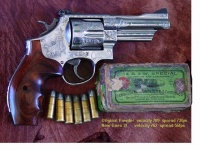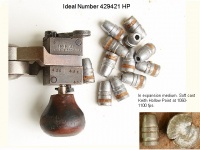.44 Smith & Wesson Special
| .44 Special | |||||||||||||
|---|---|---|---|---|---|---|---|---|---|---|---|---|---|

| |||||||||||||
| Charter Arms Bulldog with five .44 Special 246 gr LRN cartridges | |||||||||||||
| Type | Revolver | ||||||||||||
| Country of Origin | USA | ||||||||||||
| Specifications | |||||||||||||
| Parent Case | .44 Russian | ||||||||||||
| Bullet Ø | .432 in (11.0 mm) | ||||||||||||
| Neck Ø | .457 in (11.6 mm) | ||||||||||||
| Base Ø | .457 in (11.6 mm) | ||||||||||||
| Rim Ø | .514 in (13.1 mm) | ||||||||||||
| Rim Thickness | .606 in (15.4 mm) | ||||||||||||
| Case Length | 1.16 in (29 mm) | ||||||||||||
| Full Length | 1.615 in (41.0 mm) | ||||||||||||
| Primer | Large pistol | ||||||||||||
| Production & Service | |||||||||||||
| Designer | Smith & Wesson | ||||||||||||
| Design Date | 1907 | ||||||||||||
| Manufacturer | Smith & Wesson | ||||||||||||
| Production Dates | 1907— | ||||||||||||
| Ballistic Performance Sampling | |||||||||||||
| |||||||||||||
The .44 Special or .44 S&W Special is a smokeless powder center fire metallic cartridge developed by Smith & Wesson in 1907 as the standard chambering for their New Century revolver, introduced in 1908.[3]
Contents[hide] |
[edit] Development history
In the hardscrabble days of the late 1800s American frontier, large .44 and .45 caliber cartridges were considered the epitomes of handgun ammunition for self protection and hunting. Blackpowder-based rounds such as the .44 American, .44 Russian, .44-40 Winchester, and .45 Colt enjoyed a well-earned reputation for effective terminal ballistics, accuracy, and reliability.[4]
With the dawn of the 20th century, Smith & Wesson decided to celebrate the new epoch by introducing a brand new revolver design which they appropriately called the New Century model, also known as the .44 Hand Ejector, or 1st Model of 1908. In common parlance of the time it also become known as the Triple Lock.[5]
Smith & Wesson wished to pair their ground-breaking revolver design with a worthy new ammunition chambering.[5] In the early 1900s the state-of-the-art in ammunition technology was defined by the advent of smokeless powder; older blackpowder ammunition was in the process of being converted to smokeless. Smith and Wesson's popular .44 Russian cartridge had established a reputation for superb accuracy and was a renowned target loading, and they decided to use an improved smokeless powder version as the basis for the new round. Due to the lower energy density of the early semi-smokeless powders, prior efforts to convert the .44 Russian to smokeless had produced less than stellar ballistic performance. Smith & Wesson addressed this issue by lengthening the .44 Russian cartridge case design by 0.200-inch (5.1 mm), increasing the powder capacity by 6 grains (0.39 g).[6] The resulting design, which S&W called the .44 Special, had a case length of 1.16-inch (29 mm).[5]
[edit] Ballistics
Unfortunately the ballistics of the new cartridge merely duplicated the 246-grain (15.9 g) bullet @ 755 ft/s statistics of the .44 Russian, when the powder capacity of its case would have supported performance rivaling that of the .45 Colt and close to the .44-40. Nevertheless, the .44 Special retained its progenitor's reputation for accuracy.[3]
Picture Right Shows Smith and Wesson revolver and ballistics of black powder loads both original and with powder replaced with modern Goex FFFg. (Cumpston 2005)
[edit] The .44 Special Associates
Almost from its introduction, firearms enthusiasts and cartridge handloaders saw that the potential of the .44 Special chambering was far from being realized and by the end of the 1920s were loading it to much higher bullet velocities than factory standards.[5] Led by articles in firearms periodicals penned by gun writers such as Elmer Keith and Skeeter Skelton, a loose cadre of enthusiastic fans who called themselves the ‘.44 Special Associates’ formed.[5] Trading information such as .44 Special handloading data and tips regarding the conversion of revolvers to .44 caliber, they proliferated the belief espoused by many firearms authorities and experts that the .44 Special chambering is one of the best overall in the handgun realm.[4][5][7][8]
[edit] Elmer Keith and his Magnums
Keith, one of the most famous and popular firearms related authors at the time, developed a number of classical heavy handloads for the .44 Special, many are still highly regarded today.[5][9] He also championed the concept of higher powered big-bore revolvers with Smith & Wesson and Remington Arms, eventually leading to the development of the .357, .41, and .44 Magnums.[9] Keith's suggested designation for the proposed .44 caliber round was the '.44 Special Magnum', but when Remington Arms developed the cartridge they chose to name it the .44 Magnum. Nonetheless, the new cartridge was developed directly from the .44 Special design by simply lengthening the older case by .125 inch. Remington's stated rationale for the making of this change was to preclude higher pressured Magnum loads from being chambered in .44 Special revolvers.[10]
[edit] Current usage and loadings

Currently a variety of factory ammunition loadings are available in .44 Special, including bullet weights of 135, 165, 180, 200, 240, 246, and 250 grains (16 g) at various velocity levels.[12] Special High performance terminal ballistic loads are also offered, such as the Hornady JHP, Winchester Silvertip JHP, Speer Gold Dot JHP, Federal LHP, Cor-Bon JHP, and various other jacketed hollow point and soft point designs.[13]
[edit] See also
- List of handgun cartridges
- List of rifle cartridges
- 10 mm caliber
- Cumpston, Mike Early .44 Special Black Powder Factory Loads Leverguns.com 2005
[edit] References
- ↑ Federal Cartridge Co. website - Ballistics page. Accessed February 25 2008.
- ↑ Remington Arms Co. website - Ballistics page.
- ↑ 3.0 3.1 Hawks, C. "The .44 S&W Special" Chuck Hawks website.
- ↑ 4.0 4.1 Taffin, J. "Sixguns Beyond The .44 Magnum" Sixguns.com web site.
- ↑ 5.0 5.1 5.2 5.3 5.4 5.5 5.6 5.7 5.8 5.9 Taffin, J. "The .44 special cartridge of the century? Accurate, powerful and reliable, the .44 special really is special" American Handgunner, Sept-Oct, 2004.
- ↑ ".44 S&W Russian" GMDR website.
- ↑ 7.0 7.1 7.2 Skelton, C. "The .44 Special - A Reappraisal" Shooting Times Magazine August 1966.
- ↑ Keith, E. "The .44 Special" Darkcanyon website.
- ↑ 9.0 9.1 9.2 Taffin, J. "Taffin Tests: The .44 Special" Sixguns.com website.
- ↑ Boddington, C. "The Fabulous .44 Mag" Guns And Ammo Magazine.com website.
- ↑ Ayoob, M. "Lethal force: Selling Cowboy Action To More Than Cowboys" Shooting Industry, June, 2001.
- ↑ "Ammo Bank ammunition website".
- ↑ Cassill, M. "Feeding the Gunblast Bulldog - A Study in Terminal Ballistics" Gunblast website.

